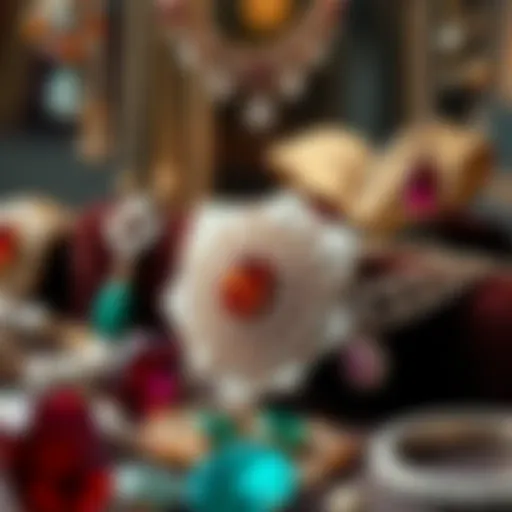Exploring the Richness of April's Diamond Gemstone
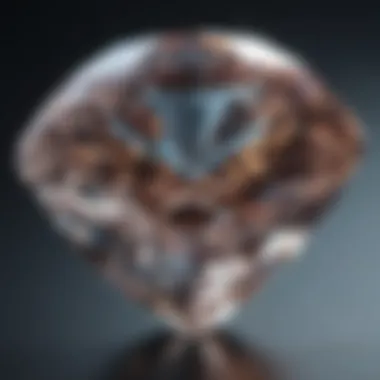

Intro
April, a month known for its showers that lead to lovely blooms, has a gemstone that sparkles with a brilliance reflecting both beauty and power—the diamond. Renowned for its clarity, durability, and allure, this gem has captured the imagination of cultures throughout history. As we dive into the layers of significance surrounding the diamond, we unravel its stories, its place not only in jewelry but in the realm of human emotion and symbolism. From weddings to engagements, diamonds stand as tokens of love and commitment, blurring the lines between simple adornment and deep personal connection.
Gemstone Overview
Description of the Gemstone
A diamond is not just a stone; it's one of nature's finest creations. Composed of carbon atoms arranged in a crystal structure known as isometric or cubic, it is the hardest known natural material on Earth. This unique configuration gives diamonds their dramatic shine and dazzling sparkle, which are often accentuated through skilled faceting. However, beyond their physical grandeur, each diamond carries a narrative, adding layers of historical and cultural significance.
Physical Properties
Diamonds come in various shapes and sizes, tailored to fit different styles and preferences. Their key physical properties include:
- Hardness: Scoring a 10 on the Mohs scale, diamonds outshine all other gemstones in durability.
- Color: While many envision diamonds as clear, they can actually be found in hues ranging from yellow to blue, pink, and even black, each carrying its own charm.
- Clarity: This refers to the presence of internal or external flaws, impacting the gem's value.
- Cut: The way a diamond is cut significantly affects its brilliance; classic cuts include the round brilliant, princess, and emerald.
Understanding these traits not only aids in the appreciation of the diamond's physical beauty but also informs potential buyers about what to look for when selecting one.
Healing Properties
Metaphysical Attributes
Beyond their allure as luxury items, diamonds hold a place in various holistic practices. Often thought of as stones of purity and enlightenment, they are believed to:
- Amplify energy, promoting clarity of thoughts.
- Enhance inner strength, aiding in guarding against negative emotions.
- Promote harmony and balance in both personal and professional relationships.
- Serve as a symbol of invincibility, reflecting the power of unwavering love and fidelity.
Many individuals incorporate diamonds in their meditation, using them as tools for enhancing focus and clarity, while some wear them as talismans for protection.
Common Uses in Holistic Practices
Diamonds frequently appear in alternative therapies that aim for better mental or emotional health. Common usages include:
- Crystal healing: Integrated into practices where energy fields are aligned.
- Wearing as jewelry: Brought into daily life, diamonds serve as constant reminders of commitment and self-worth.
- In meditation: Used to focus intentions and clear the mind during spiritual journeys.
Understanding the metaphysical aspects can enrich our appreciation of diamonds' potential, blending ancient wisdom with modern practices. This synthesis allows enthusiasts, collectors, and jewelry designers alike to perceive diamonds not just as mere gemstones, but as potent symbols with deep-rooted significance across various facets of life.
"In every diamond lies a piece of nature's story, waiting to be cherished and understood."
As we continue exploring the fascinating realm of diamonds, we'll unveil more about their historical context, buying considerations, and their ongoing relevance in today's world. This multifaceted approach will illuminate how diamonds transcend mere decorative use, tapping into emotional, spiritual, and cultural dimensions that enrich our understanding of this stunning gem.
Preface to April's Gemstone
April is not just any month on the calendar; it holds a special place in the hearts of gem enthusiasts around the world, primarily because of its gemstone: the diamond. The diamond, a symbol of endurance and luxury, plays a crucial role not only in jewelry but also in various facets of culture and symbolism. By examining the significance of this gemstone, readers gain insight into its multifaceted appeal and relevance across time.
Overview of Gemstones
Gemstones have fascinated human beings for centuries. From ancient civilizations to modern collectors, these natural treasures have been admired for their beauty and rarity. The world of gemstones is vast, comprising precious and semi-precious stones alike. A gem's value often hinges on factors like its clarity, color, and cut.
However, they are more than just pretty objects; gemstones can tell stories of geological processes, human traditions, and even personal emotions. For instance, while sapphires evoke trust and loyalty, rubies hint at passion and vitality. Each stone carries with it a unique essence and significance, making the exploration of gemstones a rich and enlightening adventure.
April and its Significance in Gemology
When we turn our sights to April, the diamond naturally stands out. This particular month not only marks the arrival of spring in many regions, symbolizing renewal and new beginnings, but it also aligns with the qualities the diamond embodies. The diamond is often known for its resilience, being the hardest known natural material. Its properties reflect the strength associated with this time of year, a time when growth starts anew.
In the realm of gemology, the April diamond is often regarded as a stone of commitment. It shines brightly as a favored choice for engagements and weddings, signifying enduring love and fidelity. On a cultural level, diamonds have dazzled royal families throughout history, epitomizing wealth and power.
In essence, April's significance in gemology extends beyond the mere physical attributes of the diamond. It encompasses profound meanings that resonate with human experiences, emotions, and aspirations. Whether one wears a diamond as a piece of jewelry or simply admires it for its beauty, the stone encapsulates a little bit of magic that intertwines with human life.
The Diamond: A Closer Look
When we dive into the realm of diamonds, we uncover more than just a pretty stone. This section aims to shine a light on the intricate details of diamonds, emphasizing their physical characteristics and formation processes. Diamonds are not merely prized possessions; they tell geological stories and carry cultural weight that transcends generations. Their hardiness, sparkling clarity, and unique development processes shape our understanding of both historical significance and modern utilization.
Physical Properties of Diamonds
Hardness and Durability
Diamonds sit at the pinnacle of the Mohs scale, holding the title of the hardest natural substance. This remarkable characteristic of hardness is a big reason why diamonds are so sought after. When we mention durability, we're not just talking about everyday wear and tear; diamonds can withstand extreme conditions with minimal wear. This impressive resilience ensures that diamond jewelry maintains its beauty for years. It's a beneficial choice for engagement rings—symbolizing enduring love—because they can withstand the test of time.
However, it's important to note that even with their hardness, diamonds can chip if met with a hard blow at the wrong angle. So, while they are incredibly tough, they aren't entirely invincible. Keeping this in mind helps jewelers and owners alike foster prudent care protocols.
Clarity and Color
Clarity is another crucial factor in assessing a diamond's desirability. The less inclusions or blemishes a diamond has, the more valuable it is. But clarity isn’t just about perfection; it’s also about character. Each inclusion can tell a story about the diamond's journey through time, creating a unique identity for the stone. Color, on the other hand, usually refers to diamons’ lack of color, with completely colorless diamonds being the most coveted.
Interestingly, diamonds come in a range of hues, from faint yellow or brown to vibrant pinks, blues, and greens. This variety opens up a world of choices for buyers and collectors. However, colored diamonds can present extra challenges for appraisers due to the subjective nature of color perception.
Cut and Carat Weight
The cut of a diamond greatly influences its aesthetic appeal and how well it reflects light. Jewelers utilize specific cut styles to maximize brilliance and sparkle, balancing between artistic expression and technical precision. The carat weight, representing size as much as weight, often plays a significant role in a diamond's value—larger stones typically commanding higher prices.
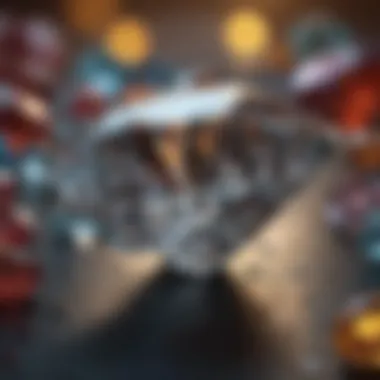

However, the focus shouldn't solely rest on size. A well-cut diamond, even if smaller, can dazzle more than a poorly cut larger stone due to light performance. It’s this balance between cut and carat that potential buyers must keep in mind when selecting a diamond.
Formation of Diamonds
Geological Processes
Understanding the geological processes behind diamond formation takes us back millions of years inside the Earth's mantle. Diamonds form under immense pressure and high temperatures, conditions that challenge our imagination. Typically, they originate around 150 kilometers beneath the surface, where carbon material undergoes significant transformations.
This process plays a vital role in how we view diamonds, as their journey from deep within the Earth to the surface is truly remarkable, adding a sense of adventure to their allure. However, the rarer the deposit, the more valuable the diamonds can become, shaping market dynamics significantly.
Time Required for Formation
Diamonds don’t form overnight; rather, it can take billions of years for these stones to come to fruition. This extensive time frame can instill a deeper appreciation among enthusiasts and collectors. The lengthy period required for their formation emphasizes their rarity, which in turn fuels their value in the jewelry market.
However, this timeframe also raises questions about sustainability and the ethical sourcing of diamonds in today's context. As awareness grows, so does the scrutiny of how these beautiful gems are obtained.
Sources of Diamonds
Diamonds can be found in various locations around the world. Traditionally, major sources included countries like Russia, Botswana, and Canada. However, rising trends towards ethical sourcing and environmental concerns are reshaping the diamond landscape. Some enthusiasts are turning towards lab-grown diamonds, which offer the same physical properties but with a significantly lower environmental footprint.
The choice leads to discussions about authenticity and value. While natural diamonds carry intrinsic historical and geological narratives, lab-grown diamonds appeal to eco-conscious consumers. This duality enriches the diamond conversation, reinforcing the complexity of their significance in modern society.
"Diamonds are not just stones but markers of time, culture, and human connection, spanning across ages and preferences."
Through this careful exploration of diamonds, from their physical properties to their intriguing formation processes, it becomes evident why they command such fascination and value. Whether you're an aficionado or simply looking to learn, the story behind each diamond encapsulates a journey worth understanding.
Historical and Cultural Perspectives
Understanding the historical and cultural significance of diamonds is crucial for appreciating their value beyond mere aesthetic appeal. Diamonds, with their brilliant sheen and unparalleled durability, have cast an enduring shadow over various cultures and epochs. Their symbolism has evolved over time, reflecting societal values, beliefs, and aspirations.
The Role of Diamonds in History
Ancient Civilizations
Diamonds first made their mark in ancient civilizations like India, where they were revered not just for their beauty but also their rarity. During this era, the diamond was often seen as a talisman, believed to bestow protection and strength. This characteristic paved the way for diamonds to be seen as more than just ornamental; they were tokens of power and divine favor. Ancient kings and warriors adorned themselves with diamond-studded armory, cherishing the notion that these stones would guard them in battle. Yet, their accessibility was limited to the elite, which shaped their perception as symbols of status. This exclusive nature of diamonds, albeit beneficial for the ruling elite, often alienated the broader populace from their allure.
Medieval Associations
Fast forward to the medieval period, and diamonds began to weave their way into the fabric of European nobility. Many believed that diamonds could ward off evil spirits and enhance the wearer’s wisdom. This connection to royalty and mysticism cemented diamonds as staples in royal regalia. One can’t overlook their role in engagements and marriage vows, with the practice of gifting a diamond ring becoming firmly established during this era. The shift towards romantic symbolism offered profound implications for future generations, embedding diamonds deep into the cultural consciousness. However, the stronger association with love and commitment also led to unrealistic expectations surrounding diamonds in relationships, establishing a weight on future generations' views towards love and materialism.
Modern Symbolism
In modern times, diamonds have transformed into icons of success and aspiration. They became synonymous with luxury and commitment, especially in Western cultures, where the phrase "a diamond is forever" resonates deeply. This tagline from the 20th century highlighted the stone's role in ensuring eternal love, influencing countless couples aspiring for the ideal romantic narrative. Yet, this modern symbolism can create a paradox; while diamonds signify achievements and milestones, their price tags often spark debates about materialism and authenticity in relationships. The challenge becomes how to enjoy the beauty and history of diamonds without getting lost in societal expectations.
Mythology and Folklore Around Diamonds
Cultural Beliefs
Across various cultures, diamonds are steeped in beliefs and folklore. In some traditions, they are viewed as stones of invincibility, capable of providing protection against harm and misfortune. This view underscores their powerful presence in rituals and significant life events. While many find comfort in these cultural beliefs, they can also lead to unrealistic associations with personal power and success. For instance, wearing a diamond as a talisman may encourage some to seek validation outside themselves, relying excessively on external symbols rather than inner values.
Legends of Power
Stories surrounding diamonds often speak of their ability to bestow power on the wearer. In ancient tales, kings and queens adorned their crowns with diamonds, believing that these gems would enhance their leadership qualities and protect their reign. Such legends often inflate the gemstones' mystique, creating a perception that only those of noble birth or exceptional strength deserve to wield such power. However, it’s essential to differentiate myth from reality. While diamonds can be enchanting, they cannot inherently ensure one's success or capabilities.
Spiritual Significance
Many cultures imbue diamonds with significant spiritual meaning, associating them with purity, clarity, and enlightenment. They are often used in meditative practices, with some individuals believing they help facilitate a connection to higher states of consciousness. Yet, while diamonds might enhance the meditative experience for some, they may inadvertently distract others from the core intent of their practice, emphasizing the importance of intention in spiritual pursuits.
In essence, diamonds encapsulate a rich tapestry of history and cultural significance, linking past traditions with contemporary beliefs. Their multifaceted identity serves as a reminder of the evolving relationship between humanity and nature’s treasures.
Understanding the historical context and cultural beliefs surrounding diamonds enriches our appreciation of these gemstones, situating them firmly within our social narratives.
Metaphysical Properties of Diamonds
Diamonds are not simply an emblem of wealth or beauty; they embody a range of metaphysical properties treasured throughout history. In this discussion, we will dissect various aspects of these ethereal aspects, connecting them to the broader narrative of the diamond's significance. By diving into these properties, we can better appreciate their historical, cultural, and emotional relevance. Just as a diamond’s facets reflect light, the metaphysical attributes can illuminate the spirit and mind, offering support and guidance in various aspects of life.
Healing Attributes
Diamonds are often lauded for their supposed healing attributes. By understanding the unique characteristics of these healing properties, one can grasp why they are celebrated not just for their physical allure but also for their claimed ability to support mental and emotional wellness.
Emotional Healing
The concept of emotional healing through diamonds has gained traction, especially among those who seek inner harmony. Diamonds are thought to aid in alleviating negative emotions and fostering positive ones. One of the key characteristics here is the stone's reputed ability to provide clarity during turbulent times. This is particularly beneficial for those grappling with loss or heartbreak. The distinct feature of diamond healing is its fierce energy. Some believe that this energy can help individuals access deep-rooted feelings and subsequently process them, offering solace during hard times. However, it's essential to recognize that while some people find comfort in bracelet adorned with diamonds, others may view such beliefs as mere superstition.
Clarity of Thought
Clarity of thought is another celebrated property linked to diamonds, and it plays a pivotal role in making pivotal decisions in life. The crystal-clear aspect of diamonds symbolizes mental clarity and focus, enhancing one's ability to think rationally. Those who place faith in the metaphysical properties often cite an increase in concentration when they engage with diamond jewelry. Consequently, for anyone seeking to sharpen their mental acuity, diamonds might be considered a worthwhile addition to their lives. However, while many treasure this aspect, others remain skeptical, attributing these effects to mere placebo rather than the actual stone.
Strength and Resilience
Strength and resilience are qualities attributed to diamonds, and it's easy to see why; after all, diamonds form under extreme conditions. Those who believe in the metaphysical powers often see wearing diamonds as a source of strength when navigating through life's challenges. Their patience and enduring nature can inspire individuals to build resilience. A unique feature here is that diamonds, through their metaphorical association with overcoming adversity, are thought to help users recognize their personal strength and capacities. Yet, it’s worth noting that while some celebrate this attribute, others can view it as overselling the gemstone's practical benefits in real-life scenarios.
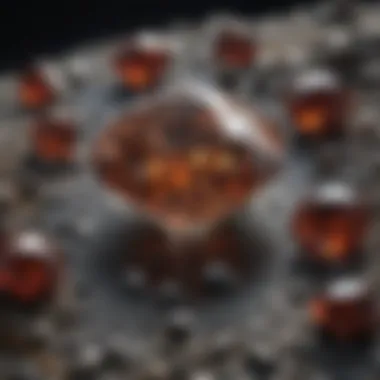

Use in Meditation
The use of diamonds in meditation practices is another dimension that has captured the interest of many spiritual seekers. While some may consider it unconventional, many practitioners regard the stone as a tool that enhances spiritual journeys and self-discovery.
Enhancing Spiritual Connection
When delving into the realm of spiritual connection, diamonds hold a special place. They are often thought to be powerful channels, bridging the gap between the physical and the divine. This special connection is crucial for those looking to deepen their spirituality. The vibrational energy associated with diamonds purportedly fosters an atmosphere conducive to meditation. Individuals report feeling a heightened sense of awareness when meditating with diamonds, making it a sought-after choice for those on a spiritual journey. However, while a diamond can undoubtedly add elegance to one’s meditation space, skeptics might argue that genuine spiritual connection ultimately relies on one’s mindset more than the physical presence of a stone.
Personal Growth and Development
Many enthusiasts regard diamonds as catalysts for personal growth and introspection. The idea is that their dazzling presence evokes a sense of beauty and worth not just outside, but within oneself. Their shimmering surface symbolizes the journey toward self-realization. Wearing or holding a diamond during reflective practices might inspire individuals to confront their pasts and aspire for a brighter future. However, perceptions of personal growth facilitated by diamonds can vary widely across individuals; some might find the incorporation of the diamond soothing, while others might feel it distracts from their efforts to meditate.
Focusing Intentions
In the context of focusing intentions, diamonds are believed to help channel one’s ideas and aspirations more effectively. Those who align with these beliefs claim that their sharpness translates into sharper focus, allowing for a clearer path towards achieving goals. The unique facet of focusing intentions through diamonds invites mindfulness about what one genuinely desires, enhancing clarity in setting purpose. Yet, while many hold this idea dearly, skeptics remind us that clarity can also stem from systematic planning rather than the influence of a gemstone.
"Diamonds can symbolize many things, from love to resilience, but their metaphysical properties delve into the realm of emotional and mental healing, offering individuals various tools for self-reflection."
Overall, the metaphysical properties of diamonds weave a tapestry of exploration and understanding into the emotional and spiritual realms. Whether one perceives these aspects as genuinely impactful or simply intriguing, the diamond’s allure as a multifaceted gem transcends its physical form. Its deeper meanings continue to resonate with those who seek more than just material wealth.
Diamonds in Jewelry Design
Diamonds have long carved their niche in the world of jewelry, serving not only as dazzling adornments but also as powerful symbols of wealth, love, and commitment. In the realm of diamond jewelry design, the choices made by artisans and consumers alike are deeply influenced by both cultural significance and personal expression. This section will unpack the importance of diamond jewelry, exploring classic designs that have stood the test of time against contemporary trends that reflect evolving values and preferences.
Classic Designs Featuring Diamonds
Engagement Rings
Engagement rings, a cornerstone of diamond jewelry, are perhaps one of the most recognizable forms of adornment. The prime aspect of engagement rings is their symbolism; they epitomize love and commitment, encasing in metal a promise for the future. Traditionally, a diamond solitaire—the single, stunning gem atop a simple band—has been hailed as the quintessential choice for engagement rings. Its clarity and brilliance encapsulate the purity of love, making it a timeless favorite.
However, modern couples often seek unique pieces that express their individual stories. While the traditional diamond engagement ring is preferred by many, there can be drawbacks. For example, some may find the standard styles lacking in personal touch, which could lead to couples searching elsewhere for a ring that resonates with their journey.
Necklaces and Bracelets
The allure of diamonds also extends seamlessly into necklaces and bracelets. These pieces offer flexibility in expressing one's style while still holding strong emotional significance. Necklaces, particularly those featuring a diamond pendant, can range from understated elegance to a bold statement piece. The versatility of designs—from the classic teardrop shape to intricate, modern settings—makes diamond necklaces a staple in any jewelry collection.
Similarly, diamonds within bracelets catch glimmers of light that dance with the wearer's movements. The trap of trends with these designs is that they might overshadow the personal connection most seek. Too often, buyers prioritize flash over sentiment, missing out on the deeper significance that these diamonds can possess.
Earring Styles
Diamonds also shine bright in the world of earrings. Ranging from stud earrings, which are often the first choice for many, to chandelier styles that dangle elegantly, these pieces serve not just aesthetic purposes but could also convey social status. Stud earrings, in particular, provide the perfect first diamond piece for newcomers, offering simplicity paired with the undeniable impact of a well-cut diamond. Nevertheless, the ease with which they are worn can sometimes render them as commonplace, leading to a search for designs that bring a breath of fresh air to the jewelry box. The charm of statement earrings, on the other hand, lies in their ability to transform even the simplest outfit into something curated and chic, but they can also become overly trendy and lose their allure over time.
Contemporary Trends in Diamond Jewelry
As we step into more innovative waters, the conversation shifts to contemporary trends in diamond jewelry design that highlight new values within the industry. Here, the focus rests on sustainability, customization, and creativity, reflecting a broader shift in consumer demand. These trends not only resonate with a conscious consumer base but also sustain the longstanding romance between diamonds and individual expression.
Sustainable Practices
In recent years, sustainable practices have taken the diamond industry by storm. With growing awareness about ethical sourcing, many jewelry designers now provide conflict-free options, addressing age-old issues surrounding the diamond trade. By prioritizing diamonds that come without moral baggage, consumers can wear their gems with a sense of pride. It's increasingly clear that eco-options are not just a trend; they are becoming boutique standards. However, this can lead to confusion over what truly qualifies as sustainable, and consumers should remain vigilant in their choices.
Unique Custom Designs
Furthermore, the rise of unique custom designs showcases an artistic turn in diamond jewelry. Gifts and heirlooms that are tailored specifically to the individual offer a personalized touch that mass-produced pieces lack. Designers are now collaborating closely with clients, creating one-of-a-kind artifacts that tell personal stories, embodying memories or significant life events. While uniqueness is a triumph, creating a custom piece can require careful planning and investment, leading some to forgo this option altogether in favor of readily available styles.
Mixed Materials with Diamonds
Lastly, the trend of utilizing mixed materials with diamonds cannot be overstated. Incorporating various metals, wood, or even fabric alongside diamonds adds dimension and a touch of creativity to traditional designs. Pieces that combine different textures can evoke emotions and tell stories, marking a departure from conventional single-metal settings. Still, while this trend opens new aesthetic possibilities, it may require careful maintenance to preserve the distinct features of each material.
Whether rooted in history or shaped by contemporary practices, diamonds in jewelry design continue to evolve, serving as a canvas for expressions of love, beauty, and individuality.
Practical Considerations for Diamond Enthusiasts
For those with an appreciation of diamonds, embarking on the journey of purchasing or caring for these stunning stones requires well-informed decisions. Navigating the marketplace, understanding how to maintain their sparkle, and ensuring their value are essential elements for every diamond enthusiast. This section shines a light on practical advice that can help individuals safeguard their investments while savoring the beauty and emotional significance diamonds hold.
Guidelines for Purchasing Diamonds
When considering a diamond purchase, knowledge is power. Saturating oneself in the details is what sets an informed buyer apart from the crowd.
Understanding the Four Cs
The foundation for evaluating diamonds rests on what is known as the Four Cs: Cut, Color, Clarity, and Carat weight. Each C plays a pivotal role in determining a diamond's overall quality and ultimately its value.
- Cut: Reflects how well a diamond has been shaped and faceted. A well-cut gem will sparkle brilliantly.
- Color: Ranges from colorless to light yellow or brown. A colorless diamond is generally regarded as more desirable.
- Clarity: Refers to the presence of inclusions or blemishes. Higher clarity means fewer visible imperfections.
- Carat Weight: Indicates the size of the diamond. Heavier stones naturally demand a higher price.
This system not just elucidates quality but acts as a benchmark for enthusiasts seeking value in their acquisitions.
Recognizing Authenticity
With the market brimming with options, recognizing the authenticity of a diamond is vital. Not every sparkle is genuine, and enthusiasts must be alert to potential fraud.
- Certification: Always opt for diamonds that come with a certification from notable gemological institutions like the Gemological Institute of America (GIA).
- Retailer Reputation: Trustworthy vendors usually provide guarantees of quality and authenticity.
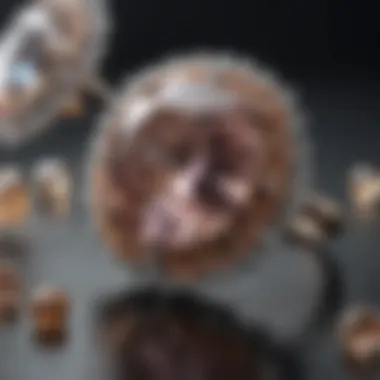

By leaning into these essentials, consumers can feel confident in their purchases and ensure they are investing in real, high-quality stones rather than imitations.
Choosing Reputable Vendors
The importance of selecting a reliable vendor cannot be overstated. The right vendor can make all the difference in the diamond-buying experience.
- Establishment: Look for vendors with a longstanding reputation. Longevity can often imply trustworthiness.
- Transparency: A good vendor should be open about the diamond’s details, including their sourcing and grading.
Taking the time to select the right vendor not only protects one’s investment but also enhances the overall buying experience.
Caring for Diamond Jewelry
To maintain the allure of diamonds, proper care is essential. A little knowledge goes a long way in preserving their beauty.
Cleaning Techniques
Cleaning diamonds should not be an afterthought; regular upkeep maintains their shine and brilliance.
- Simple Soap and Water: A mild soap in warm water can effectively clean dirt and oils. Using a soft toothbrush can help reach crevices.
- Professional Cleaning: Regular professional services can rejuvenate diamonds, revealing their true sparkle.
Choosing the right cleaning technique is paramount. While home methods work, yearly professional clean-ups are invaluable for longevity.
Storage Recommendations
When it comes to storing diamond jewelry, considerations greatly affect their condition over time.
- Avoid Scratching: Store diamonds separately to avoid scratching each other or other jewelry.
- Use Proper Cases: Soft fabric pouches or padded cases can shield them from dust and damage.
The right storage solutions can save diamonds from unnecessary wear and tear, enabling them to be cherished for generations.
Insurance Considerations
Insurance is a safeguard that protects diamond investments and affords peace of mind.
- Valuation: Have a certified appraisal done to determine the true worth of the diamond for insurance purposes.
- Policy Types: Explore policies specifically designed for jewelry, which often provide more comprehensive coverage.
Having insurance not only cushions against loss or damage but also affirms the responsibility that comes with owning and loving a valuable item like a diamond.
By understanding the nuances of purchasing, caring for, and insuring diamonds, enthusiasts can effectively preserve their unique charms and the stories they carry.
The Future of Diamonds
The future of diamonds is a multifaceted topic, reflecting broader changes in societal values, environmental concerns, and individual preferences. As the world evolves, so do the expectations surrounding the diamond industry. Ethical sourcing, innovation in gemstone creation, and the shifting demands of consumers are at the forefront of this transformation.
Ethical Sourcing and Synthetic Diamonds
Conflict-Free Diamonds
Conflict-free diamonds have emerged as a critical aspect of the gemstone industry, spotlighting the human and environmental implications behind diamond mining. These are diamonds sourced from regions where no humanitarian issues, particularly armed conflicts or abusive labor practices, are present. The importance of conflict-free diamonds lies in their assurance that each stone bought supports ethical practices, thus appealing to the socially conscious buyer.
A unique feature of conflict-free diamonds is the certification system that assures consumers of their ethical origins. This can significantly boost a buyer's confidence, knowing their purchase aligns with their values. However, the diamond market still has veins of challenges related to transparency and the reliability of certification processes. Ensuring that the entire supply chain adheres to ethical standards is paramount for maintaining consumer trust.
Lab-Grown Alternatives
Lab-grown diamonds are fast gaining traction and could redefine what diamonds mean in the future. Created in controlled environments, these diamonds possess nearly identical properties to their mined counterparts, but often come at a lower price point. They are popular because they are seen as sustainable options that mitigate the environmental impact caused by traditional diamond mining.
With lab-grown diamonds, consumers can enjoy high-quality gemstones without the ethical baggage associated with mining. On the downside, some traditionalists argue that they lack the natural mystique and history linked to mined diamonds. Nonetheless, lab-grown alternatives present a modern response to the industry’s ethical dilemmas and consumer needs.
Market Trends
Current market trends indicate a significant shift toward more sustainable and ethical products is shaping the diamond landscape. With younger generations showing an inclination for environmentally conscious purchasing, diamonds that are ethical or lab-grown are becoming increasingly appealing. A major characteristic of these trends is their reflection of a wider societal movement towards sustainability and responsibility in consumption.
Moreover, the ongoing emergence of technology has facilitated accessibility and transparency in the diamond market. Buyers today can leverage technology to understand their purchase better, compare options, and choose products that resonate with their values. The downside? As ethical options grow in popularity, traditional diamond sellers may need to adapt, or risk being left behind.
Evolving Trends in Gemology
Technological Advancements
Technological advancements are reshaping not only how diamonds are mined but also how they are sold and perceived. From improved mining techniques to enhanced grading systems, technology plays a crucial role in increasing the availability and quality of diamonds.
One key characteristic is the use of blockchain technology to ensure authenticity and trace the origins of diamonds, thereby adding an extra layer of trust in a market often marred by uncertainty. These advancements may open avenues for innovation, yet they also present challenges in keeping pace with consumer expectations in terms of ethical sourcing and sustainability.
New Discoveries
New discoveries in diamond formation and sources can transform the landscape of gemology. Scientists continually uncover previously unknown deposits, expanding the geographical reach of where diamonds can be ethically sourced. Simultaneously, novel formations and chemical compositions might influence their value and desirability.
While these discoveries can diversify the market, they also necessitate a closer examination of local ecological impacts, as new mining practices could pose risks to previously untouched environments.
Consumer Preferences
Consumer preferences are perhaps the most direct indicator of the market's future direction. As individuals become increasingly educated about ethical issues and sustainability, their purchasing habits reflect these values. A noted shift towards more transparency, individualized designs, and preferences for ethically sourced stones marks a significant departure from traditional values.
While this growth is beneficial for brands that adapt to these changes, those that remain stuck in the past may find a rocky road ahead. Enriching the marketplace with diverse, purpose-driven products will likely cater to the next generation of diamond enthusiasts and reflect broader societal changes.
"Sustainability isn’t just a trend; it’s a necessary adjustment in a world increasingly taking notice of its own environmental footprint."
Looking ahead, the diamond industry stands at a crossroads where ethical considerations, technological advancements, and consumer demands converge. Embracing these changes will not only redefine what diamonds stand for but also pave the way for a new era in which beauty and responsibility go hand in hand.

